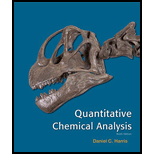
(a)
Interpretation:
The mass of precipitate contained in the crucible has to be calculated and the number of significant digits in that mass has to be given
Concept Introduction:
Significant Figures:
While reporting a reading of a measurement, the digits that are considered to be significant irrespective of the place of location of decimal point are called significant figures.
All the digits in a measurement except zero are considered significant, whereas zero is considered as significant only when it lies in the middle of the digit or at the end of number on the right-hand side of a decimal point.
(a)
Answer to Problem 3.AE
The mass of the precipitate contained in the crucible is
The number of significant figures present in the given mass is three
Explanation of Solution
Given data:
The weight of the empty crucible is
The weight of the same crucible containing a precipitate after the gravimetric analysis is
The mass of both the crucible has six significant digits.
Mass of the crucible:
The mass of the precipitate is obtained by finding the difference between two crucibles and is calculated as follows,
Therefore, the mass of the precipitate is
The number of significant figures in the obtained mass of precipitate is three
The mass of the precipitate contained in the crucible is
The number of significant figures present in the given mass is three
(b)
Interpretation:
The absolute and relative uncertainty in mass of the precipitate has to be calculated and the mass with a reasonable number of digits has to be written
Concept Introduction:
Uncertainty:
Uncertainty means state of not certain in predicting a value. In a measured value, the last digit will have associated uncertainty. Uncertainty has two values, absolute uncertainty and relative uncertainty.
Absolute uncertainty:
Expressed the marginal value associated with a measurement
Relative uncertainty:
Compares the size of absolute uncertainty with the size of its associated measurement
For a set measurements having uncertainty values as
(b)
Answer to Problem 3.AE
The absolute uncertainty of the mass of the precipitate is
The relative uncertainty of the mass of the precipitate is
Explanation of Solution
Given data:
The weight of the empty crucible is
The weight of the same crucible containing a precipitate after the gravimetric analysis is
The mass of both the crucible has six significant digits.
The manufacturer states that the balance has an uncertainty of
Absolute Uncertainty in mass:
Assume,
The initial reading as
The final reading as
Convert grams to milligrams.
The mass of the precipitate is obtained from the difference between these two crucible values.
The uncertainty (e) is calculated as follows,
On writing the obtained value in significant figure, the uncertainty in mass is calculated as
Therefore, the absolute uncertainty of the mass of the precipitate is
Relative uncertainty:
The relative uncertainty is calculated as follows,
The percent relative uncertainty is calculated as follows,
Therefore, the relative uncertainty of the mass of the precipitate is
The absolute uncertainty of the mass of the precipitate is
The relative uncertainty of the mass of the precipitate is
Want to see more full solutions like this?
Chapter 3 Solutions
Quantitative Chemical Analysis
 ChemistryChemistryISBN:9781305957404Author:Steven S. Zumdahl, Susan A. Zumdahl, Donald J. DeCostePublisher:Cengage Learning
ChemistryChemistryISBN:9781305957404Author:Steven S. Zumdahl, Susan A. Zumdahl, Donald J. DeCostePublisher:Cengage Learning ChemistryChemistryISBN:9781259911156Author:Raymond Chang Dr., Jason Overby ProfessorPublisher:McGraw-Hill Education
ChemistryChemistryISBN:9781259911156Author:Raymond Chang Dr., Jason Overby ProfessorPublisher:McGraw-Hill Education Principles of Instrumental AnalysisChemistryISBN:9781305577213Author:Douglas A. Skoog, F. James Holler, Stanley R. CrouchPublisher:Cengage Learning
Principles of Instrumental AnalysisChemistryISBN:9781305577213Author:Douglas A. Skoog, F. James Holler, Stanley R. CrouchPublisher:Cengage Learning Organic ChemistryChemistryISBN:9780078021558Author:Janice Gorzynski Smith Dr.Publisher:McGraw-Hill Education
Organic ChemistryChemistryISBN:9780078021558Author:Janice Gorzynski Smith Dr.Publisher:McGraw-Hill Education Chemistry: Principles and ReactionsChemistryISBN:9781305079373Author:William L. Masterton, Cecile N. HurleyPublisher:Cengage Learning
Chemistry: Principles and ReactionsChemistryISBN:9781305079373Author:William L. Masterton, Cecile N. HurleyPublisher:Cengage Learning Elementary Principles of Chemical Processes, Bind...ChemistryISBN:9781118431221Author:Richard M. Felder, Ronald W. Rousseau, Lisa G. BullardPublisher:WILEY
Elementary Principles of Chemical Processes, Bind...ChemistryISBN:9781118431221Author:Richard M. Felder, Ronald W. Rousseau, Lisa G. BullardPublisher:WILEY





